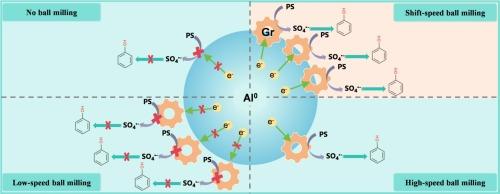变速球磨制备Al/C复合材料的界面工程及高效过硫酸盐活化
IF 6.9
2区 材料科学
Q2 CHEMISTRY, PHYSICAL
引用次数: 0
摘要
零价铝(Zero-valent aluminum, ZVAl)是一种新型的水处理材料,具有优异的还原性能。本研究通过新型变速球磨技术开发了一种石墨改性ZVAl复合材料(Gr@ZVAlssbm),该复合材料具有应力调节的化学键结合界面。该合成过程包括两个阶段:(i)短暂高速铣削破坏ZVAl上的被动氧化层,从而暴露出新的活性表面供Gr锚定,然后(ii)延长低速铣削以实现均匀的Gr分散,并加强ZVAl与Gr之间的键合状态。这种双阶段方法不仅促进了有机污染物在复合表面的富集,而且优化了电子转移路径。这种独特的方法显著提高了复合材料的过硫酸盐(PS)活化性能。实验结果表明,Gr@ZVAlssbm对0.1 mM苯酚的去除率达到99.64 %,比传统的ZVAl(32.52 %)有了很大的提高。反应机理是ZVAl通过导电Gr快速转移ZVAl释放的电子,并有效激活PS生成硫酸盐自由基(SO4−)和羟基自由基(OH),可用于去除水中的苯酚。本文首次提出了一种采用变速球磨法制备可降解污染物的铝碳复合材料的新方法。本文章由计算机程序翻译,如有差异,请以英文原文为准。

Interfacial engineering of Al/C composites through shift-speed ball milling for efficient persulfate activation
Zero-valent aluminum (ZVAl) is a newly developed material for water treatment due to its superior reduction capabilities. This study develops a graphite-modified ZVAl composite (Gr@ZVAlssbm) with a stress-modulated chemically bonded interface via novel shift-speed ball milling. The synthesis involves a two-stage process: (i) brief high-speed milling to fracture the passive oxide layer on ZVAl, thereby exposing fresh active surfaces for Gr anchoring, followed by (ii) extended low-speed milling to achieve homogeneous Gr dispersion and strengthen the bonding state between ZVAl and Gr. This dual-stage approach not only promotes the enrichment of organic pollutants on the composite surface but also optimizes the electron transfer path. This unique method significantly enhances the composite’s performance in persulfate (PS) activation. Experimental results demonstrate that Gr@ZVAlssbm achieves 99.64 % removal of 0.1 mM phenol, representing a substantial improvement compared to conventional ZVAl (32.52 % only). The reaction mechanism is that ZVAl rapidly transfers electrons released from ZVAl through conductive Gr and efficiently activates PS to generate sulfate radicals (SO4 −) and hydroxyl radicals (
−) and hydroxyl radicals ( OH), which can be used to remove phenol from water. In conclusion, a new method for the preparation of aluminum-carbon composites for pollutant degradation by shift-speed ball milling is proposed for the first time.
OH), which can be used to remove phenol from water. In conclusion, a new method for the preparation of aluminum-carbon composites for pollutant degradation by shift-speed ball milling is proposed for the first time.
 −) and hydroxyl radicals (
−) and hydroxyl radicals ( OH), which can be used to remove phenol from water. In conclusion, a new method for the preparation of aluminum-carbon composites for pollutant degradation by shift-speed ball milling is proposed for the first time.
OH), which can be used to remove phenol from water. In conclusion, a new method for the preparation of aluminum-carbon composites for pollutant degradation by shift-speed ball milling is proposed for the first time.
求助全文
通过发布文献求助,成功后即可免费获取论文全文。
去求助
来源期刊

Applied Surface Science
工程技术-材料科学:膜
CiteScore
12.50
自引率
7.50%
发文量
3393
审稿时长
67 days
期刊介绍:
Applied Surface Science covers topics contributing to a better understanding of surfaces, interfaces, nanostructures and their applications. The journal is concerned with scientific research on the atomic and molecular level of material properties determined with specific surface analytical techniques and/or computational methods, as well as the processing of such structures.
 求助内容:
求助内容: 应助结果提醒方式:
应助结果提醒方式:


